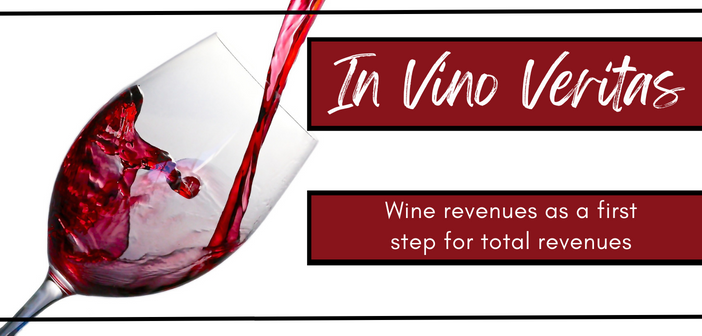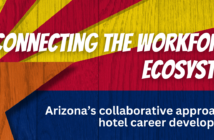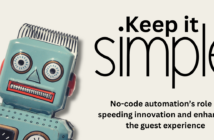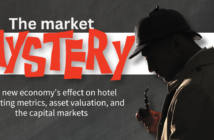Wine revenues as a first step for total revenues
After several years of seemingly unending upheaval, recovery, and potential recession, it’s time to face facts. The travel landscape will always have some looming obstacle acting as the barrier to smooth operations and steady returns. No matter the news cycle, we can make a broad prediction about the hotel industry: Brands in every category are transitioning away from a purely ‘heads in beds’ model (RevPAR) to a more holistic one that synthesizes multiple profit centers in revenue per guest forecasts.
Call it total revenues per available room (TRevPAR). Call it revenue per available guest (RevPAG). Whatever the acronym we all eventually standardize around, at its core the lesson is that hotels must start breaking down departmental silos and taking actions that will pad any occupancy gaps or rate stagnation with more ancillary spend so there’s a consistent topline.
But isn’t this an article about wine revenues? Yes, it is, but what will become clear is that the mindset and procedural shift necessary to facilitate more beverage upselling has far broader implications for how you maximize revenues in any other non-rooms income stream.

MARIYANA M/SHUTTERSTOCK.COM, VALENTYN VOLKOV/SHUTTERSTOCK.COM
WHY WINE RIGHT NOW?
In an agonizingly labor-tight world, you would think we would start a TRevPAR discussion with something like parking or hotel fees, which are high-margin and labor-light profit centers. But it’s precisely because most restaurants are break-even and currently enduring staffing shortages, supply chain disruptions, or inflationary food costs that we start with wine.
To learn more about specific tips and tricks to boost your wine sales, check out Adam and Larry Mogelonsky’s latest book, “In Vino Veritas: A Guide for Hoteliers and Restaurateurs to Sell More Wine,” where they explore tactics and techniques like:
- How to upsell a table from wine by the glass to by the bottle or half-bottle.
- Understanding the importance of different glassware and corks versus screw caps.
- Knowing an overview of all the key growing regions to inform what your hotel stocks.
- Harnessing newer trends like orange wines, dessert wines, and pétillant naturel.
- How to position other alcoholic beverages like craft beers, whiskey, and other spirits.
If you can make an F&B outlet profitable by building a solid beverage strategy, revamping your training, and harnessing the power of integrated technologies to hone team productivity, then you can do just about anything. Onsite restaurants also are the most common ancillary amenity in hotels, thus giving wine sales near-universal applicability, while a great dining experience, as amplified by great wine, will psychologically halo onto a customer’s overall satisfaction with the guestroom.
Getting wine to work for you means that you have to look into:
1 Server training on wine to ensure they’re armed with the right knowledge to effectively sell table-side to customers (where staff tastings can also work as good teambuilding exercises).
2 Your POS, inventory, purchasing and accounts payable systems to ensure everything is properly itemized, analyzed, and seamlessly reordered.
3 Incorporating wine as a valueadded voucher in your rooms’ packages (subject to local laws), requiring proper data connections between your POS and PMS as well as how you promote these on the booking engine, front-end website, social media, or newsletters.
4 Automated pre-arrival upselling tools that can help you refine the timing and messaging by which you optimize ancillary guest spend.
5 Wine as a room service, or welcome amenity offering, which – to execute in a labor-efficient manner – requires a service operations platform and online ordering via a guest-facing app.
6 A robust guest experience management system that can give you better analytics on who is buying wine, what offers work, and the ideal time so you can retarget these profiles.
UNDERSTANDING EMOTIONS THROUGH WINE
All technology upgrades aside for the moment, the fascinating thing about wine is that every bottle ever sold contains essentially crushed and fermented grapes. Yet, within those broad parameters – and the reason the two of us are head-over-heels passionate about this beverage – is a world of possibilities, nuanced flavors, transcontinental history and, above all, stories. This last part is mission critical because, when it comes to wine (or anything for that matter), it’s all about perceptions. What you are selling pales in comparison to how you sell.

NUMBER 86/SHUTTERSTOCK.COM
A simple, two-part thought experiment illustrates this. For the first half of the research study, participants were given two samples of red, then told that one was priced at $10 per glass and the other was $90 per glass. Predictably come, the majority preferred the more expensive sample. Spoiler alert: they were both the same wine.
Here’s where it gets interesting. For the second part, all participants were given two samples of red, both at $90 per glass. But half the subjects were simply told the price while the other half were supplied with an elaborate story about where the wine came from and how it was harvested. You guessed it: Price held equal, people showed a significant preference for the wine with a narrative behind it. Moreover, these participants were hooked up to an fMRI machine (measuring brain wave activity), revealing that, beyond mere words conveyed to the experimenters post-hoc, the story itself excited sizably more of the brain’s pleasure centers.
Again, it’s about how you sell far more than what you are selling. For instance, knowing its average customer isn’t a luxury hotel guest, a select-service hotel may opt for stocking low-cost prosecco over champagne because the latter is just too expensive to get any meaningful sales volume. But, what’s the messaging around this bottle to frame it as a fun add-on to boost the hotel experience? How are hotels repeating that messaging and making it as convenient a purchase as possible? How are your various teams being made aware of this new prosecco offering as well as the software deployed to automate all the digital interactions where this wine can be purchased?
WINE IS ABOUT TEAMS AND TECH
It’s this last point that should be re-emphasized, not only because wine is purchased based on emotions but also because your technologies are only as good as the teams behind them, and this is why we created the ‘TNT Audit’ program that looks to optimize a hotel’s tech system as well as the managerial workflows behind the scenes so that every system is used effectively.
From the same example above, suppose a restaurant manager puts that prosecco on the menu but doesn’t inform any other key members of the executive committee? Without this information, how do the revenue manager and marketing manager know to start thinking of ways to incorporate the prosecco into a package? How do they know to update the online ordering app, upselling platform, or hotel website? How does the sales manager know whether or not to consider this new item for the catering menu to help boost F&B sales for group events?
While the future of hotels is all about using technologies to ramp up team productivity, the concurrent trend is the breaking down of siloed communications so a property can fire on all cylinders. It’s likely the abovementioned lack of communication occurs partly because every manager is mired in busywork and seemingly inconsequential updates, like a new bottle of prosecco on the menu, fall through the cracks.
Thus, ramping up wine revenues mandates both better use of technology as well as updates to how your teams work together. If a restaurant manager is too busy dealing with supply chains and purchasing orders, then perhaps it’s time to upgrade your procurement system and automate more accounting workflows. If an F&B director is too busy dealing with staffing turnover, you have to re-evaluate your pay-scale and other non-wage incentives you can deploy to retain team members.
Thinking more holistically, if revenue-builders like wine aren’t being shared across departments due to too many meetings, then you have to ask why. Why do your managers have to meet all the time? Can you expedite an hour-long meeting into 30 minutes? Why does every manager have to be present for this meeting? How are you structuring meetings with a minutes taker and specific follow-up actions so everyone is accountable? Can you offload the entire meeting onto a work management platform?
When considering both your teams and your tech, wine is but the tip of the iceberg for creating a virtuous circle of growing TRevPAR that extends to all other F&B as well as any other profit centers like the gift shop, spa, third-party activity providers, online gift cards, room service app (which, by the way, garner a significantly larger “cart size” over calling down to the front desk), or even your check-in kiosks and onsite display screens like the in-room television.
Thinking in terms of revenue per guest requires a systemic change. It isn’t easy and it won’t be fast, so start with wine and build out from there. And, of course, don’t drink and drive.





